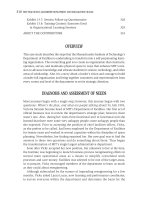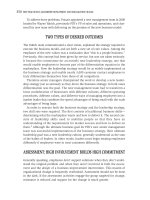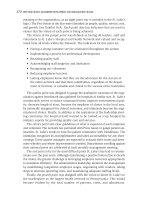Tài liệu Best Practives in Leadership Development & Organization Change 3 pptx
Bạn đang xem bản rút gọn của tài liệu. Xem và tải ngay bản đầy đủ của tài liệu tại đây (123.94 KB, 10 trang )
system. Many of the study’s programs were specific to the behaviors required of
coaches and managers who facilitate the performance management process. First
Consulting Group’s creation of targeted objectives to assist in achieving the
organization’s vision through an intensified and streamlined leadership develop-
ment program, incorporating 360-degree/multi-rater feedback, suggests that
leaders previously lacked self-awareness. MIT used adapted models based on the
work of Peter Senge, organizational learning capabilities, and W. Warner Burke’s
key competencies for organizational learning. These models frequently form
the basis of multi-rater and other competency-based assessment tools, and often
provide a focal point to the systemic design of the program itself.
Strong Top Management Leadership Support and Passion
Top leaders at the organization must not only budget for the change and lead-
ership development initiative, they must also strongly believe in the initiative
and model this behavior throughout the organization. Support from senior man-
agement has been identified by 88 percent of the contributors as a critical step
in overcoming resistance to change.
GE Capital energized its business leaders by designing its program around its
leaders’ behaviors and values, a focus that generated buy-in in high levels of the
organization, and by having participants work on projects for the office of
the CEO. Windber Medical Center’s patient empowerment program was driven
by its CEO, Nick Jacobs. In his account of Windber’s organizational change
program and what drove its emphasis for patient-centered care at the hospital,
President Jabobs writes, “When a patient walks into the typical hospital, the over-
whelming confusing signage, the smell of antiseptics, the curt and often unfor-
giving attitude of the employees, and the awesome power of the physicians are
usually clear indicators that they should leave their dignity at the door.” Jacobs
is passionate about patient care, and it shows in the programs that he has
supported for years.
When Agilent first became an independent entity, its CEO made development
of future leaders one of his first priorities. He drew on initiatives already in place
to ensure buy-in and then improved on these processes by making them
universally applicable. First Consulting Group demonstrated a strong sense of
support from top-level executives through its creation of the Leadership
Development Committee, which included the CEO, two vice presidents, and an
eighteen-member task force of director and vice president-level staff, whose
responsibility was to aide in conducting organizational assessment and bench-
marking survey data to assist in the development of future organizational
leaders. At Praxair, the change team recommended a four-step leadership strat-
egy design process to engage Praxair Distribution, Inc.’s (PDI’s) top 175 man-
agers in assessing the current state of the leadership practices and the changes
required for PDI employees to become a sustainable source of competitive
xx
INTRODUCTION
cart_14399_flast.qxd 10/20/04 12:36 PM Page xx
advantage. Former chairman and CEO of Honeywell Larry Bossidy’s zeal for Six
Sigma was without a doubt exactly what the company needed to get this ini-
tiative off the ground and on the radar screen of every leader and employee.
FCG is unique in that the firm’s CEO and executive committee serve as facilita-
tors to the Leadership First program sessions, and one member is required to
be a sponsor for the participants.
A STEP-BY-STEP SYSTEM TO ORGANIZATION AND HUMAN
RESOURCES DEVELOPMENT
The Best Practices Institute has defined a six-phase system to leadership
and organization change, which may be seen in most of the case studies in
this book:
1. Business diagnosis
2. Assessment
3. Program design
4. Implementation
5. On-the-job support
6. Evaluation
Phase One: Business Diagnosis
The first phase is usually a diagnostic step in which the business drivers and
rationale for creating the initiative are identified. Critical to this stage is enabling
consensus and a sense of urgency regarding the need for the initiative. A future
vision that is supported by management is a key factor of success for these pro-
grams. All of the systems have some model as a focal point for their work. The
best of these models capture the imagination and aspirations of employees and
the entire organization. Designing the system also leads to strategic questions,
such as those taken from the GE Capital example:
• What are biggest challenges facing the business—what keeps you awake
at night?
• If you had one message to future leaders of this business what would
it be?
• What will leaders need to do to address the business challenges?
• What is it that you want to be remembered for as a leader?
• What was your greatest defining moment that taught you the most
about leadership?
• What excites you most about your current role?
INTRODUCTION
xxi
cart_14399_flast.qxd 10/20/04 12:36 PM Page xxi
HP conducted a survey on “Reinventing HP.” More than seven thousand
managers and individual contributors responded. Several themes emerged that
underscored the need to accelerate decision making and collaboration. Respon-
dents throughout the organization recognized the need to accelerate decision
making and increase accountability for action, thereby reinforcing senior
management’s call for greater agility.
A well-thought-out diagnostic phase is usually connected to an evaluation of
the desired business impacts in Phase Six.
Phase Two: Assessment
Assessments range from GE Capital’s assessment system (in which participants
complete a 360-feedback survey that includes a question to describe a particu-
lar person at peak performance) to the Myers Briggs Type Indicator (MBTI) to
the Leadership Impact Survey (a survey that correlates leader behavior with
organization culture and value) to First Consulting Group’s system (in which
individual participant assessment is conducted with five vehicles: participant
self-assessment, 360-degree and multi-rater feedback, external benchmarks,
managerial style profile, and behavioral needs profile).
Assessment has become a norm for business. The question is how we use
the assessment to drive change in our businesses and ourselves. Agilent used
it to develop leadership behavioral profiles based on the company’s strategic
priorities, core values, and expectations of those in senior leadership roles.
StorageTek performed an internal scan to determine what components of
transformation were lacking. Praxair conducted the assessment process to
prepare the organization for future changes by engaging more than five hun-
dred employees: 175 leaders in the top three levels of management and over 325
employees across all fifteen regional businesses. Organizations such as General
Electric, Intel, Motorola, McDonald’s, and others use behavioral analysis tools
such as the Myers-Briggs Type Indicator or 360-degree assessments. Individual
coaching often accompanies this assessment to facilitate behavioral change in
participants. This coaching has been extremely successful for firms such as GE
Capital, Intel, Agilent, McDonald’s, and others.
Phase Three: Program Design
The following outstanding programs have several unique elements that are
worthy of note.
• Coaching. Intel’s coaching and mentoring system features internal
coaches and a support network of program participants and graduates.
Emmis Communications used coaching to help managers overcome
resistance to cultural change.
xxii
INTRODUCTION
cart_14399_flast.qxd 10/20/04 12:36 PM Page xxii
• Selection of participants. Agilent’s coaching program has a results guar-
antee so employees are required to undergo a qualification process,
including an interview before being allowed to participate. Intel uses an
application process to screen out apathetic or disinterested candidates.
McDonald’s selects only high-potential candidates chosen by their
division presidents.
• Action learning. General Electric, Mattel and McDonald’s use action
learning as an integral part of their leadership development systems. In
particular, General Electric’s action learning program focuses on solving
real business problems, whereas McDonald’s centers around operational
innovations. These programs address such questions as
What is a “doable” project that still expands thinking?
How do we set senior management’s expectations for the business value
that the learning will produce?
How do action teams stay together as learning groups over time?
• Leveraging multiple tools. Every organization from Mattel to GE Capital
took great care to use a variety of methods to train, develop, and inno-
vate. At Hewlett-Packard (HP), the final design was a fast-paced pro-
gram that interspersed presentations with small group work, practice,
and discussions in order to provide sufficient depth and practice without
overwhelming the participants or requiring excessive time out of the
office. At Mattel, a small group was recruited to participate in an immer-
sion program that included the use of floor-to-ceiling chalkboards and a
twelve-by-forty-foot pushpin wall that acted as living journals, and self-
discovery speakers to help each participant discover a renewed sense of
self and expressiveness.
• Use of current practices. Corning uses past strengths and successes to
leverage future success. Through focusing on history and storytelling,
Corning is able to increase entrepreneurial behavior. StorageTek was
careful to build its organizational changes upon programs and practices
that were already in place in order to lend a sense of stability and
consistency to its initiatives.
• Connection to core organizational purpose. St. Luke’s Hospital and
Health System embraces some basic concepts that foster a culture of ser-
vice excellence and form the basis of its models for leadership develop-
ment such as its management philosophy, vision for patient satisfaction,
PCRAFT core values, service excellence standards of performance, and
performance improvement plan. These concepts include
1. Employee satisfaction yields patient satisfaction yields a successful
“business” (Build your people . . . they build your business)
INTRODUCTION
xxiii
cart_14399_flast.qxd 10/20/04 12:36 PM Page xxiii
2. Employee satisfaction begins and ends with effective leaders who
provide vision, clear expectations regarding care and service,
development and education, effective communication, role modeling,
constructive feedback, and recognition
3. Effective leaders can and need to be developed
4. Leadership development and education is based on educating to
change behavior
At Windber Medical Center, there was a clear program built on the following
transformational changes. The organization determined that it would focus on
patient-centered care as the number-one priority of the organization; provide a
loving, nurturing environment to the patients and their families; address all
patient and patient family issues quickly and efficiently; and become recognized
locally, regionally, and nationally for this new type of commitment to care that
did not compromise the patients’ dignity.
Phase Four: Implementation
Almost all of the initiatives have a formalized training and development pro-
gram or workshops to propel the change or development process into action.
The following are components of several noteworthy training and development
workshops:
• Lockheed Martin trained leaders to teach new behavioral competencies to
their employees in order to overcome their own resistance through public com-
mitment to the behavioral competencies. Lockheed Martin also focused on a
group of opinion leaders within the company to influence their peers during the
cultural change effort.
• First Consulting Group’s program, Leadership First, prides itself on employ-
ing a situational approach rather than a more typical subject matter approach by
incorporating case studies based on actual FCG work and scenarios. Unlike many
other programs that focus on motivation and communication, FCG’s program
focuses on various skills. For example, when completing a merger case study, the
potential leader must focus on a variety of issues: financial, legal, business and
revenue implications, emotional, motivational, and communication. FCG is also
unique in that the firm’s CEO and executive committee serve as facilitators to the
sessions, and one member is required to be a sponsor for the participants.
• Mattel’s Project Platypus centered on individual development in order to
maximize creativity directed toward product innovation. Trust, respect, and
communication were all encouraged through the use of storytelling, creative
culture speakers, and “face-to-face” connection. Outside experts such as a
Jungian Analyst and a Japanese Tea Master helped hone the team’s observa-
tional skills. Using the concepts of postmodernism and the company as a living
xxiv
INTRODUCTION
cart_14399_flast.qxd 10/20/04 12:36 PM Page xxiv









